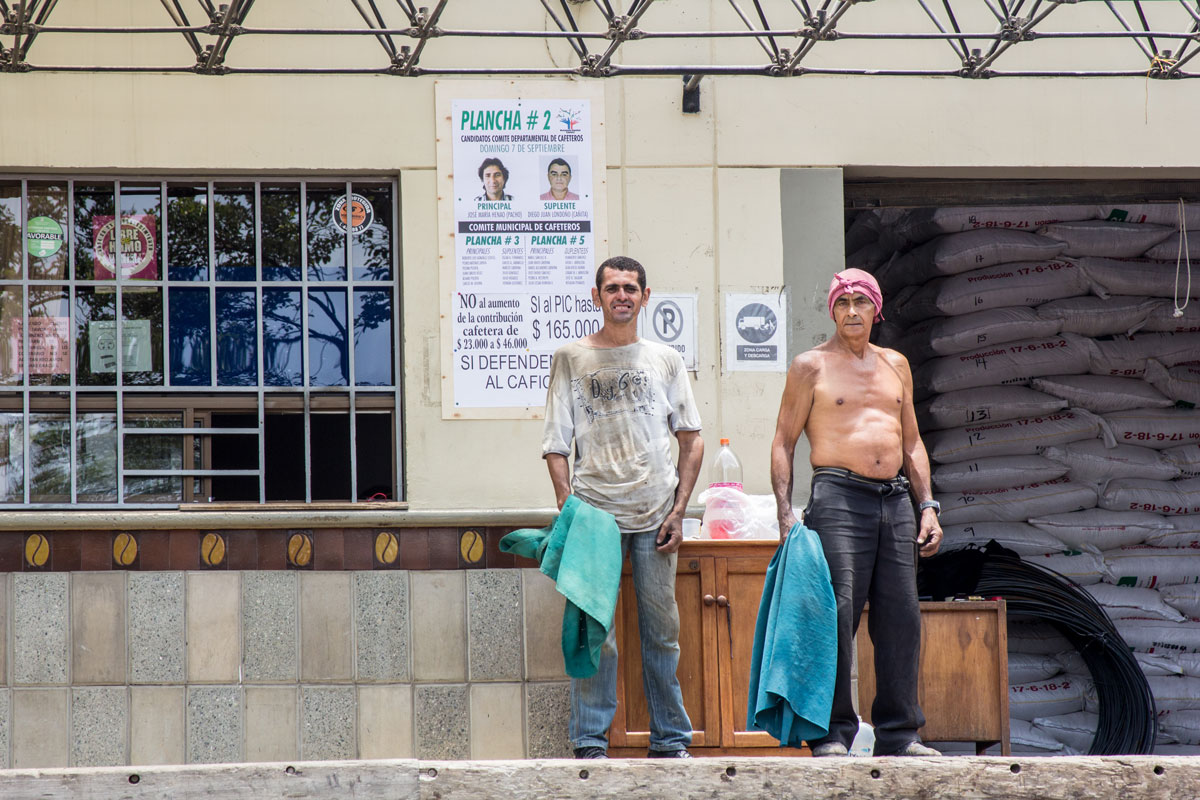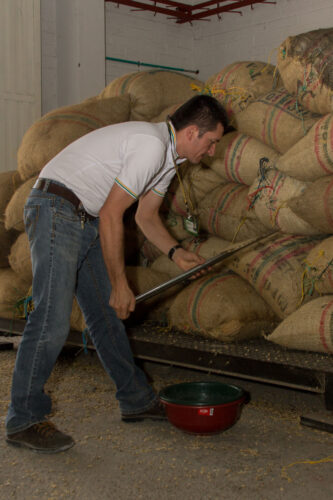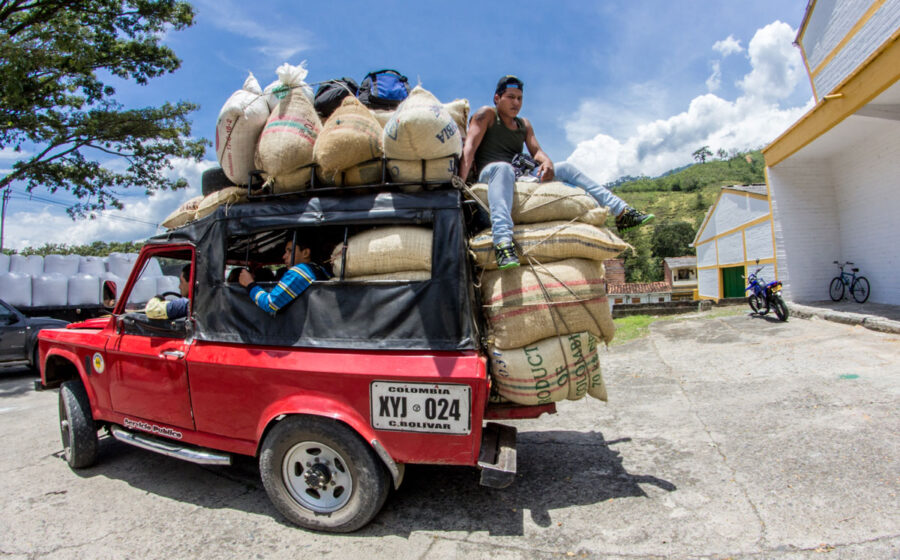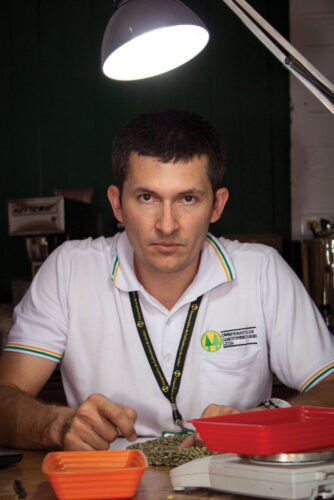[I] first met Leon Bedoya in April, 2013, when a friend dropped me at the coffee purchasing warehouse of the De los Andes Cooperativa, better known as Cooperandes, in Ciudad Bolivar, Antioquia, Colombia. Dressed in jeans and a polo shirt, he stood to greet me as I entered the co-op. He introduced himself with a joke about his name, saying, “I’m Leon, but don’t worry, I’m a tame one!” He laughed heartily, his sense of humor overlapping with his professionalism. He shook my hand as firmly as any businessman and told me to put away my pen and paper and to have a seat at his desk, where a pile of green coffee he had been about to sort for defects lay on the black Formica countertop illuminated by a desk lamp. “You’ll only learn what goes into buying Colombian coffee if you try it for yourself,” he told me as I settled into his chair.
Leon’s job at Cooperandes is, simply, to buy dry parchment coffee from the growers in the region. His full job description, complexly, entails all the intricacies of navigating the social, agricultural, and environmental realities of the area’s coffee production culture and the larger spheres of Colombia’s national coffee policies, international certification organizations, and commodity futures on New York’s Intercontinental Exchange “C” market. The view from his desk provides a unique position from which to simultaneously observe the financial and agricultural poles of the coffee industry.
Cooperandes is one of four cooperatives of coffee producers in Antioquia, Colombia’s largest coffee growing region. All Antioquian co-ops work closely with the National Coffee Growers Federation, better known by its Spanish acronym, FNC, a guild of elected representatives that, at least theoretically, advocates for the nation’s more than half a million coffee growing families by administering government subsidies, marketing Colombian coffee internationally, and spearheading diverse development programs. The FNC is also the regulatory body for the export of the country’s coffee and it stipulates how exporters, of which Antioquia’s co-ops are some of Colombia’s largest, should operate.
Outfitted with a modest desktop computer and a few unique tools, including a well-used hollow metal sampling spear, Leon is one of the gatekeepers of the coffee world. During my stay in Bolivar, Leon served as my Colombian coffee buying tutor. He abides by the mandates of Cooperandes and the FNC, but the exact price a producer gets for his or her coffee literally rests in his hands as he evaluates a producer’s green coffee beans for defects, thereby granting a premium or deducting a penalty for quality. He generates the receipt that dictates a family’s budget. He is the bearer of good and bad price news. He is a messenger for producers to the coffee organizations and a data collector for the co-op and the FNC, a sort of coffee Hermes flitting between the world of growers and coffee Olympus.

The coffee is brought to the warehouse in Jeeps, trucks, and cars, packed away on buses, slung over mules’ backs, and even carried in by the producers themselves. The cargo can be a kilogram or 30,000 kilograms, says Leon. Once it’s reached the warehouse, the co-op’s strongmen haul the sacks of arriving coffee off their mode of transport and onto the scales, then off the scales and into a designated section of the warehouse. Once the sacks have been weighed, it’s Leon’s job to jab each sack with the sampling spear and pull beans from each bag. He blends the speared beans from the bags into a quarter-kilo sample.
Leon says, “This is where we evaluate the quality of the coffee, to reward producers if it’s excellent quality coffee or reduce the price according to the exact percentage of defects. . . . After analyzing the coffee, we verify if the producer is enrolled in any special program of verification or certification. We proceed to store this coffee in the appropriate bay so that there’s a traceable chain of custody. For every kilo that a producer turns over to the co-op we generate a receipt. This helps us have better traceability for the product so that we know how many kilos a producer sold, the value of each kilo, and the total value the producer was paid for that coffee,” he says. “We do the same process for every producer, whether for one, ten, or 100 kilos of coffee.”

Producers have to like the work; if they don’t they can’t call themselves caficultores. They have to understand that it’s a perennial crop, one that takes at least two years to produce a harvest; they have to understand the months of patience necessary. It’s a cultural question. One of patience, one of passion.”
He was raised with this passion. “My father is a caficultor; he’s been a caficultor his whole life. His farm gave us our education. We’re five siblings, two women and three men. Both my parents are still alive, and my dad spends every day still going up to the farm, doing little jobs there. When I have free time I help him; it’s something we grew up with and from which we’ve lived. It’s something that deserves to be loved and we’re all very proud of it.”
[A]ntioquia contains the extremes of Colombian coffee production, with both large estates and miniscule plots. Cooperandes’ general manager Juan Rendon says that 600 of the co-op’s 3,600 landholding members, including the largest and the smallest, fall under the immediate jurisdiction of Ciudad Bolivar and Leon. He is responsible for receiving heavy-hitting local estate owners and humble farmers tending tiny family plots of land.

“We have to interact with producers in a very friendly way so that they feel happy to be selling to us and proud to be here, in the co-op. It’s my job to make them feel well taken care of. They tell us stories of their farms, how production is going, if trees are affected by any insect or disease attack, like broca or roya,” says Leon, using the Spanish words for the coffee berry borer beetle and leaf rust. “They ask us what we recommend to treat the problems, and we send them to the co-op’s technical assistants so that they can help them troubleshoot, so that they can have a good, quality harvest.”
Many co-ops and exporters are starting to teach producers to cup so they can demonstrate how defects and positive farm management techniques present in the cup, though it may take a generation before producers with cupping experience becomes the norm. While that shift slowly takes place, Leon helps flatten the coffee learning curve. A brochure might claim that over-fermentation degrades the quality of coffee, but buyers can vouch for this type of information firsthand, communicating it in layman’s terms.
It’s more than agricultural advice, though. “We practically become emotional advisors, comparable to a psychologist or something!” Leon says. “Everyone tells stories of their families, problems they had out in the fields, with workers on the farm, or beautiful experiences working in the mountains where they were born. Culturally, that’s where producers are rooted, where they’ve raised their children. Some have sent their kids to university with coffee.”

That’s not the face they present. Producers always enter the co-op with an air of confident bravado, saying, “Just you wait! This will be the best coffee you’ve graded all day—zero defects!” when they are often holding their breath that the quality will at least be on par. Like the banter of haggling at a bazaar, it’s a requisite producer pastime to gripe and groan as the buyer evaluates the sample. Producers will feign disgust and cry, “But that’s not a defect! You’re trying to rob me blind!” and then be secretly happy their coffee earned the price it did. Leon enjoys this game. “Buying coffee is an art that you learn, and I like to interact with people. I like the daily dialogue. I like sharing my days with producers,” he says.
“The price has to be fair and objective. The producer has to be able to make enough to tend to the farm and have some sort of profit. It depends on the time of year he sells his coffee, because there are times when the price drops really low, and that kind of economy affects everyone.” Right now, on my visit, coffees coming into the warehouse can earn $1.46 per pound, which Leon says the farmers are happy with. A year before, though, they could pull less than seventy-five cents per pound. “Many producers wanted to close their farms, sell their properties, move onto something else,” says Leon. “But now that there’s been a rally in prices, they’re calm, back to work, happy.

Buyers are the front lines of implementing new co-op plans of action devised in response to international roaster purchasing trends. Leon, in his white monogrammed polo shirt, is about to change the way this region of Colombia grows coffee.
Co-ops typically don’t taste individual producers’ coffee before they purchase it, because it all gets mixed together at the central mill before being hulled and sorted for export. But in the search for the highest quality coffees, it’s not enough to just physically analyze the beans; coffees must be cupped to discover their attributes. The co-op has seen what is so common in first-world cafés: specialty roasters will pay for micro-lots that show something special.
Leon’s branch is the first Cooperandes warehouse to cup its producers’ coffees, which not only gives the co-op the opportunity to find micro lots it can sell at premiums, it gives the producers the chance to earn additional premiums, learn what their coffee actually tastes like, and see how it measures up to international standards.
“Grading based on sensory analysis motivates the producer to be even more attentive to quality, and it lets us be even more confident selling to our buyers. We can be even surer that the coffee Cooperandes exports has all the attributes of coffee grown here in the mountains of the Andes region of Antioquia,” Leon says.
As Leon cups samples and awards premiums, he is an emissary of quality, preaching the message that better coffee pays better. His cupping desk is proof that consumer demands can shape the market and eventually do reach all the way to producer organizations and their members.
—Rachel Northrop is a freelance writer and author of When Coffee Speaks.
















